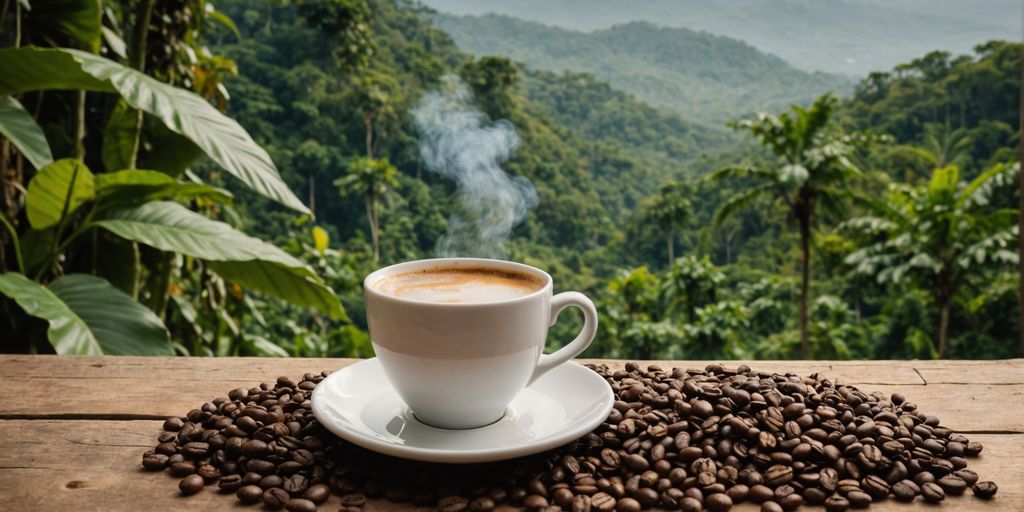Central America is a coffee lover’s dream. From the lush hills of Costa Rica to the volcanic soils of Guatemala, this region offers a rich tapestry of coffee cultures and traditions. Each country tells its own unique story of how coffee is grown, harvested, and enjoyed. Whether you’re a casual coffee drinker or a dedicated aficionado, exploring these coffee routes will give you a deeper appreciation for your daily cup.
Key Takeaways
- Costa Rica’s coffee culture is deeply rooted in history and sustainability.
- Ecuador produces both Arabica and Robusta coffee, thanks to its diverse ecosystems.
- Guatemala’s coffee traditions are influenced by its rich cultural heritage and volcanic soil.
- Central America offers immersive coffee tours where visitors can experience the coffee-making process firsthand.
- Sustainable practices are crucial for the future of coffee farming in Central America.
Exploring Costa Rica’s Coffee Culture

Costa Rica is a paradise for any Coffee Traveler. The country’s coffee culture is rich and deeply rooted in its history, geography, and sustainable practices. Let’s dive into what makes Costa Rican coffee so special.
The History of Coffee in Costa Rica
Costa Rica’s coffee journey began in 1779 when the first beans were brought from Cuba. By 1832, coffee had become one of the country’s primary exports, earning the nickname "grano de oro" or "golden grain." The warm climate, distinct wet and dry seasons, and fertile volcanic soil create the perfect conditions for growing high-quality coffee beans. Costa Rica is renowned for its prized Arabica beans, specifically the Caturra and Catuaí varieties.
Unique Coffee Growing Regions
Costa Rica boasts eight distinctive coffee-growing regions: Burnca Region, Turrialba, Tres Ríos, Orosi, Tarrazú, Central and Western Valleys, and Guanacaste. Each region offers a unique flavor profile, thanks to the diverse microclimates and soil conditions. On a coffee plantation tour, you can experience firsthand how these factors influence the taste of the coffee.
Sustainable Coffee Farming Practices
Costa Rica is a leader in sustainable coffee farming. Nearly 93% of the country’s electricity comes from renewable resources, and 26% of its land is protected. Coffee farmers use eco-friendly techniques like drip irrigation to reduce water consumption and grow beans under canopy shade to promote biodiversity. These practices not only protect the environment but also ensure the long-term viability of coffee farming in the region.
Visiting Costa Rica’s coffee plantations offers a unique opportunity to see how tradition and innovation come together to create some of the world’s best coffee. From the misty mountain slopes to your cup, every step of the journey is a testament to the country’s commitment to quality and sustainability.
Ecuador’s Coffee Heritage
Arabica vs. Robusta: Ecuador’s Dual Coffee Production
Ecuador is unique because it produces both Arabica and Robusta coffee. This is due to its diverse ecosystems, rich volcanic soils, and consistent temperatures. Arabica coffee is typically grown in higher altitudes, while Robusta thrives in lower regions. This dual production allows Ecuador to cater to different tastes and markets.
Manabi: The Heart of Ecuadorian Coffee
The coastal province of Manabi is the largest producer of Arabica coffee in Ecuador. Coffee was first cultivated here in the 19th century, and the region continues to be a significant player in the coffee industry. The unique climate and soil conditions in Manabi contribute to the distinct flavor of its coffee.
Volcanic Soil and Coffee Quality
Ecuador’s coffee benefits greatly from its volcanic soil, which is rich in nutrients. This type of soil enhances the flavor and quality of the coffee beans. The volcanic regions, including the island province of the Galapagos, produce coffee with a unique taste that is highly sought after by coffee enthusiasts.
The nutrient-rich volcanic soil in Ecuador not only boosts the flavor of the coffee but also supports sustainable farming practices, making it a win-win for both farmers and coffee lovers.
Ecuador’s coffee heritage is a blend of tradition, unique growing conditions, and a commitment to quality that makes it stand out in the world of coffee.
Guatemala’s Coffee Traditions
Antigua: A Coffee Lover’s Paradise
Antigua is a must-visit for any coffee lover. The city is not only beautiful but also a hub for some of the best coffee in the world. Walking through the streets, you’ll find numerous coffee shops where you can taste the rich and complex flavors of Guatemalan coffee. The beans often exhibit a harmonious blend of chocolate and cocoa notes, making each cup a delightful experience.
From Bean to Brew: The Coffee Process
Ever wondered how your coffee goes from a simple bean to a delicious brew? In Guatemala, you can see the entire process firsthand. From picking the ripe coffee cherries to drying and roasting the beans, every step is crucial. The care and attention given to each stage ensure that the final product is nothing short of amazing.
Cultural Significance of Coffee in Guatemala
Coffee is more than just a drink in Guatemala; it’s a way of life. The coffee industry supports many local communities and is deeply intertwined with the country’s culture and traditions. Whether you’re visiting a small farm or a large plantation, you’ll see how important coffee is to the people of Guatemala.
Visiting Guatemala gave me a new appreciation for coffee. Seeing how much effort goes into every cup made me realize why Guatemalan coffee is celebrated worldwide.
Immersive Coffee Tours in Central America

What to Expect on a Coffee Plantation Tour
When you join a coffee plantation tour, you’re in for a treat. You’ll start with a walk through lush fields where coffee cherries grow. It’s amazing to see how these cherries are picked by hand. You’ll learn about the whole process, from planting to harvesting. The best part? You get to taste the coffee right where it’s made.
Hands-On Coffee Harvesting Experiences
Ever wanted to pick coffee cherries yourself? On these tours, you can! You’ll get to work alongside local farmers and see how they pick only the ripe cherries. It’s a fun and educational experience. Plus, you’ll appreciate your cup of coffee even more after seeing all the hard work that goes into it.
Tasting Tours: Savoring the Flavors
Tasting tours are a must for any coffee lover. You’ll get to try different blends and learn how factors like soil and roasting affect the flavor. It’s a sensory adventure that will make you love coffee even more. Don’t miss out on this chance to savor the flavors of Central American coffee.
These tours offer a unique way to connect with the local culture and understand the effort behind every cup of coffee.
The Impact of Volcanic Soil on Coffee

Nutrient-Rich Soil and Coffee Flavor
Volcanic soil is packed with minerals that are essential for coffee plants. This nutrient-rich soil helps the plants grow strong and healthy, which in turn makes the coffee taste better. The minerals in the soil give the coffee beans a unique flavor that you can’t find anywhere else.
Volcanic Coffee Plantations in Costa Rica
Costa Rica is famous for its coffee plantations located on the slopes of volcanoes. Places like the Doka Estate and Café Britt offer tours where you can see how the volcanic soil helps the coffee plants grow. The soil here is so good that it makes the coffee taste rich and full-bodied.
How Volcanoes Shape Coffee Cultivation
Volcanoes play a big role in coffee farming. The ash and lava from eruptions break down and turn into soil that is perfect for growing coffee. This soil is full of nutrients that help the coffee plants thrive. When you drink a cup of coffee from a volcanic region, you’re tasting the result of this amazing natural process.
Sustainable Coffee Practices in Central America

Eco-Friendly Farming Techniques
In Central America, coffee farmers are embracing eco-friendly farming techniques to protect the environment. One popular method is shade-grown coffee, where coffee plants grow under a canopy of trees. This not only conserves biodiversity but also provides a habitat for wildlife. Another technique is using organic fertilizers instead of chemical ones, which helps maintain soil health and reduces pollution.
Supporting Local Communities
Coffee farming in Central America isn’t just about the beans; it’s about the people too. Many coffee farms are family-owned, and by supporting these farms, you’re helping local communities thrive. Fair trade practices ensure that farmers get a fair price for their coffee, which can improve their quality of life. Additionally, some farms offer educational programs and healthcare services to their workers, making a positive impact on the community.
The Future of Sustainable Coffee
The future of sustainable coffee in Central America looks promising. Farmers are continually adopting new technologies and methods to make coffee production more sustainable. For example, some are using drip irrigation systems to conserve water. Others are experimenting with new coffee plant varieties that are more resistant to diseases and pests. With these innovations, Central America is leading the way in sustainable coffee farming.
Conclusion
Traveling through Central America on a coffee journey is more than just a trip; it’s an adventure that connects you with the heart and soul of the region. From the volcanic soils of Costa Rica to the rich traditions of Guatemala, each cup of coffee tells a story of dedication, culture, and history. As you sip your way through these beautiful landscapes, you’ll gain a deeper appreciation for the hard work and passion that goes into every bean. So, whether you’re a coffee aficionado or just someone who enjoys a good brew, this route offers an unforgettable experience that will leave you with a newfound love for coffee and the people who make it possible.

